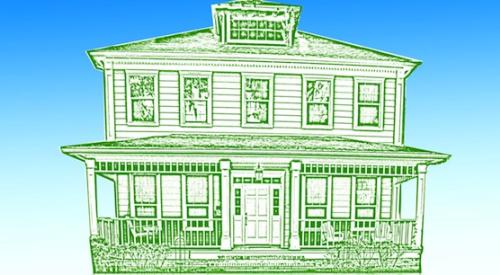|
Does market share really matter? And if it does, why do even the largest home builders in most markets struggle to achieve market share greater than 10 percent? Can anyone do today what Ray Ellison Homes did in San Antonio in the 1980s — reach a market share greater than 60 percent?
We have data from many retail trades that shows dominant market share does, in fact, correlate to superior financial results. The PIMS (Profit Impact of Market Strategy) database was created in 1972 by the Harvard Business School to test business management theory. Today, it is managed by the Strategic Planning Institute, and now contains more than 32 years of data on over 2000 companies. Analysis by the Strategic Planning Institute suggests that long-term relative market share is a proxy for long-term relative financial results.
The SPI analysis defines its terms as follows:
- Long-term is a four-year average.
- Relative market share relates the positions of the three largest competitors.
- Financial results refers to pre-tax return on total capital.
There's plenty of evidence that home building is no exception to this rule. The median public home builder is now producing close to a 25 percent pre-tax return on total capital (twice the cost of capital). The average lead builder in the top 50 markets has almost a 10 percent share, with a relative share of 43 percent (averaged over the last four years). The PIMS database suggests that such leaders should approach a 31 percent pre-tax return on total capital.
Let's not misunderstand, however. Long-term relative market share in itself does not produce the financial results. It is, in reality, a proxy for the steps that do:
- Superior relative quality is achieved by a combination of skillful product and service design and proper selection of market segments to serve.
- Providing superior quality enables a successful business to charge premium prices and still gain market share.
- By gaining share, the business attains scale and/or experience-based cost advantages over its competitors.
- Higher profitability follows as a result of premium prices, at the same time costs are equal to — or less than — those of competitors. For example, if a builder reaches market leadership, that scale of operations usually creates advantages in purchasing and procurement of capital and land. Such a home builder can even turn cyclical changes into a competitive advantage — pushing margins when the market is hot, then dropping them a little to go after even greater market share when it cools.
How do you reach for "good" share growth, the kind we describe here, as opposed to market share "bought" through predatory pricing that actually erodes financial performance?
Keep two things in mind. The first is the choice of correct sub-markets. The second is to develop a balanced set of tactics to build share within those sub-markets.
Every building company produces its best returns where its 'prejudice for value' most closely reflects that of the market.
The Charlotte market strategic space map (on page 23) illustrates this process. The market has been subdivided, by price, into five sub-markets (or quintiles) of equal size. Key builders (those with greater than a 1 percent share) are displayed, sorted by their average sales prices — which is one way to assess where their value prejudices are closest to those of the market.
NVR leads this market with just a 6.31 percent absolute share, versus the national average of 10.0 percent. NVR will have difficulty reaching a 10.0 percent share from its current concentration of strength in the 4th quintile price point. The firm's value prejudice is at a relatively high price point, which will not allow it to reach deep into the second or first quintile with "balance." Typically, to reach 10 percent market share, it is necessary for a firm to have its strength concentrated in the middle of the third pricing quintile, in order to maintain balance across all price points.
John Wieland Homes and Neighborhoods' strategy in the Charlotte market is an interesting one. The firm's goal is to dominate not the whole market, but only quintile five. Wieland knows that its value prejudice will not play across a balanced portfolio, but it will in quintile five. A builder's long-term average sales price and its quintile position offer strong hints to where it will be financially successful. This forces the builder to balance unit volume against return per unit. Wieland's strategy is to dominate the one quintile where the firm knows it can please buyers and make money.
Choose Correct Tactics MixMarket share is built by investments in place, product, price and promotion. Place is the number of locations and their geographic distribution. Product is the number of house plans built and the perceived quality of those plans in the eyes of home shoppers. Price is the number of quintiles covered and the spec-adjusted performance of the firm in price per square foot. Promotion is the perception created by marketing and sales investments. Balanced investment in all four produces share growth with the greatest returns.
You need a significant share of building locations to get a significant share of house sales. And they can't all be in one quadrant of the market geographically. To build dominant share, you have to be in two or more quadrants, preferably all four. If you want to dominate quintile five pricing and you have no locations in the key quintile five geographic corridor, you will never reach a dominant share. It takes balance and volume to reach a great "place" score.
If you survey shoppers, how well does your product score against the competition on street presence of the elevations and traffic pattern efficiency of the floor plans? There are perhaps 20 different measures that can be used to score product.
If you only build in one pricing quintile, you can never reach more than a 20 percent share of the total market. But it's hard to be good in more than three quintiles. Think of how many product lines and house plans you would have to build, and how many locations you would have to buy. To build through four quintiles, a builder will probably even need different sets of subcontractors.
Promotion really has three aspects: traffic counts, closing ratio against those traffic counts and the perceived quality of marketing promotions, ads, signs, brochures, etc. This gets complex, and expensive, when product offerings stretch across multiple pricing quintiles.
Many builders invest most in their strongest tactic rather than make investments in their weakest. Some may think they can win in the marketplace because every one of their locations is an "A" site. Or because their product is so incredible, it doesn't matter where they build it. Or because they consistently have the lowest price per square foot.
Those are all ineffective ways to build market share. Profitable share requires balanced investment in all the tactical areas. It's like a chain: only as strong as its weakest link, but you need multiple links to have something that works. Share will grow, with better financial results, when you address your weakest tactic rather than continuing to over-invest in the strongest.
Barriers Above 10 percent ShareIt's hard for any builder today to grow beyond a 10 percent share in a top 50 housing market. There are a few exceptions, such as KB Home in San Antonio (thanks to its acquisition of the remnants of Ray Ellison's empire), and M/I Homes' domination of its hometown of Columbus, Ohio, which has exceeded 20 percent at times.
However, the competition is already fierce in most major markets and growing tougher every day. And the value prejudice of one company in a single market can only cover so much and continue to improve financial results. Every building company builds houses a certain way — and it will run into trouble if moving into a price quintile requires it to build a different way.
Quintile four and five builders have trouble dropping specs to reach the value prejudice of the market at quintile one or two. Builders in those lower price quintiles find it tough building houses better to move up to quintile four or five. One company embracing such a broad spectrum of vision, values and volume goals can easily lose its way.
When I was at Crosland Communities in Charlotte N.C., we got to 25 percent market share, second only to Ray Ellison in San Antonio. So we climbed on a plane to go see what they were doing. The capital turns were incredible, but we came away with the sense that Ray wasn't in the home building business as much as land speculation. They controlled a full circle of land around the city, but didn't build on it. Instead, they went out to the next circle, with the strategy that building there would increase the value of the land in the inner circle. They owned huge amounts of land — a risky business.
The other piece of the puzzle was the unique nature of the San Antonio market, which was largely military, with very narrow pricing bands. The quintiles were very tight, so it was not nearly as much of a stretch to build across four, or all five, with a single organization.
It would be difficult for any builder to reach that level of market domination today, in San Antonio or anywhere else.
The Acquisition ErrorOne way builders — especially public ones — try to overcome the limits of reach from an established value prejudice is via acquisition. If the builder is strongest in quintile four or five, then why not acquire a local company that specializes in quintile one or two? It's a solid strategy, but one that usually goes awry because the acquisitor tries to consolidate certain operations and — in the process — ends up destroying the very value prejudice it sought to acquire.
You have to be careful what functions — if any — you choose to consolidate. Land acquisition and development can probably be united for two disparate home building companies. Anything that's business-to-business will work. But everything that touches the customer should never be united. That contradicts the value prejudice of the acquired company.
Where so many acquiring companies mess up is when they consolidate elements that touch the retail side of the business. They end up with a hodgepodge that's neither one nor the other. That's a recipe for declining market share and bad financial results. It's amazing how often big public builders acquire a small local firm to extend market share and end up losing all of that share with a decision to consolidate the brand.
Something goes wrong with the acquired company and, rather than fix it, they just roll it into the parent corporation.
It's always better to have multiple brands. Buyers have a prejudice against buying a $350,000 house from the same company that builds at $120,000. I think that's more than just a prejudice. It's really buyer intelligence.
| QUINTILE | I | II | III | IV | V | |||
| Price | <$130,000- | $130,001 | $157,001 | $197,001 | ||||
| $157,000 | $197,000 | $280,500 | >$280,500 | |||||
| Units | 3,150 | 3,150 | 3,150 | 3,150 | 3,150 | |||
| Builder | Total Share | Ave Share | Ave Price | |||||
| Simonini | 0.27 | 1.36 | 1.36 | $968,420 | ||||
| Poore | 0.16 | .86 | 0.85 | $795,790 | ||||
| QUINTILE V | ||||||||
| Wieland | 2.36 | 11.73 | 11.73 | $501,420 | ||||
| Orleans | 1.56 | 1.91 | 5.86 | 3.88 | $337,670 | |||
| Niblock | 1.42 | 3.30 | 3.63 | 3.46 | $301,430 | |||
| St.Lawrence | 1.16 | 1.27 | 3.95 | 2.61 | $314,870 | |||
| Shea | 3.21 | 0.77 | 8.10 | 7.11 | 5.32 | $285,460 | ||
| QUINTILE IV | ||||||||
| M/I | 1.03 | 0.83 | 2.92 | 1.34 | 1.69 | $256,760 | ||
| Arvida | 2.60 | 0.33 | 1.50 | 2.05 | 6.39 | 2.71 | 2.59 | $236,670 |
| NVR | 6.31 | 2.42 | 3.72 | 8.11 | 11.63 | 5.61 | 6.29 | $216,990 |
| Pulte | 2.59 | 1.06 | 4.10 | 6.80 | 0.92 | 3.22 | $215,490 | |
| Horton | 2.67 | 1.21 | 2.31 | 4.62 | 3.30 | 1.91 | 2.67 | $203,180 |
| Centex | 4.47 | 2.06 | 5.63 | 4.52 | 6.23 | 3.86 | 4.46 | $204,930 |
| QUINTILE III | ||||||||
| Hovnanian | 2.18 | 0.69 | 0.81 | 5.67 | 3.50 | 0.25 | 2.18 | $188,740 |
| Ryland | 3.19 | 1.67 | 4.16 | 5.23 | 3.91 | 0.92 | 3.19 | $185,590 |
| Lennar | 1.60 | 1.08 | 2.69 | 1.83 | 1.65 | 1.81 | $185,120 | |
| MDC | 2.67 | 2.94 | 6.35 | 3.88 | 4.39 | $182,920 | ||
| QUINTILE II | ||||||||
| KB | 2.58 | 2.58 | 5.50 | 3.88 | 0.73 | 0.16 | 2.58 | $154,060 |
| Eastwood | 2.73 | 1.34 | 6.47 | 5.74 | 4.51 | $151,280 | ||
| Mercedes | 1.08 | 2.09 | 1.38 | 0.83 | 0.95 | 0.16 | 1.08 | $149,870 |
| Stand. Pacific | 1.44 | 2.87 | 2.44 | 1.57 | 0.19 | 0.16 | 1.44 | $145,880 |
| Homelife | 2.69 | 3.33 | 6.66 | 3.33 | 4.44 | $144,970 | ||
| Mulvaney | 1.58 | 2.94 | 2.63 | 2.31 | 2.62 | $141,960 | ||
| Craft | 1.42 | 2.42 | 3.69 | 0.80 | 2.30 | $141,090 | ||
| Beazer | 4.35 | 8.85 | 8.38 | 4.30 | 7.17 | $139,330 | ||
| QUINTILE I | ||||||||
| Liberty | 0.79 | 3.89 | 3.89 | $106,320 | ||||
| TOTAL MRK | ||||||||
| Top 3 Bldrs | 15.13 | 16.07 | 21.15 | 20.20 | 26.53 | 24.71 | ||
| Leader's Relative % | 41.70 | 55.07 | 38.95 | 40.14 | 43.83 | 47.48 | ||
| Source: 4Q04 MORE Reports & Newton Graham Consultants | ||||||||
|












